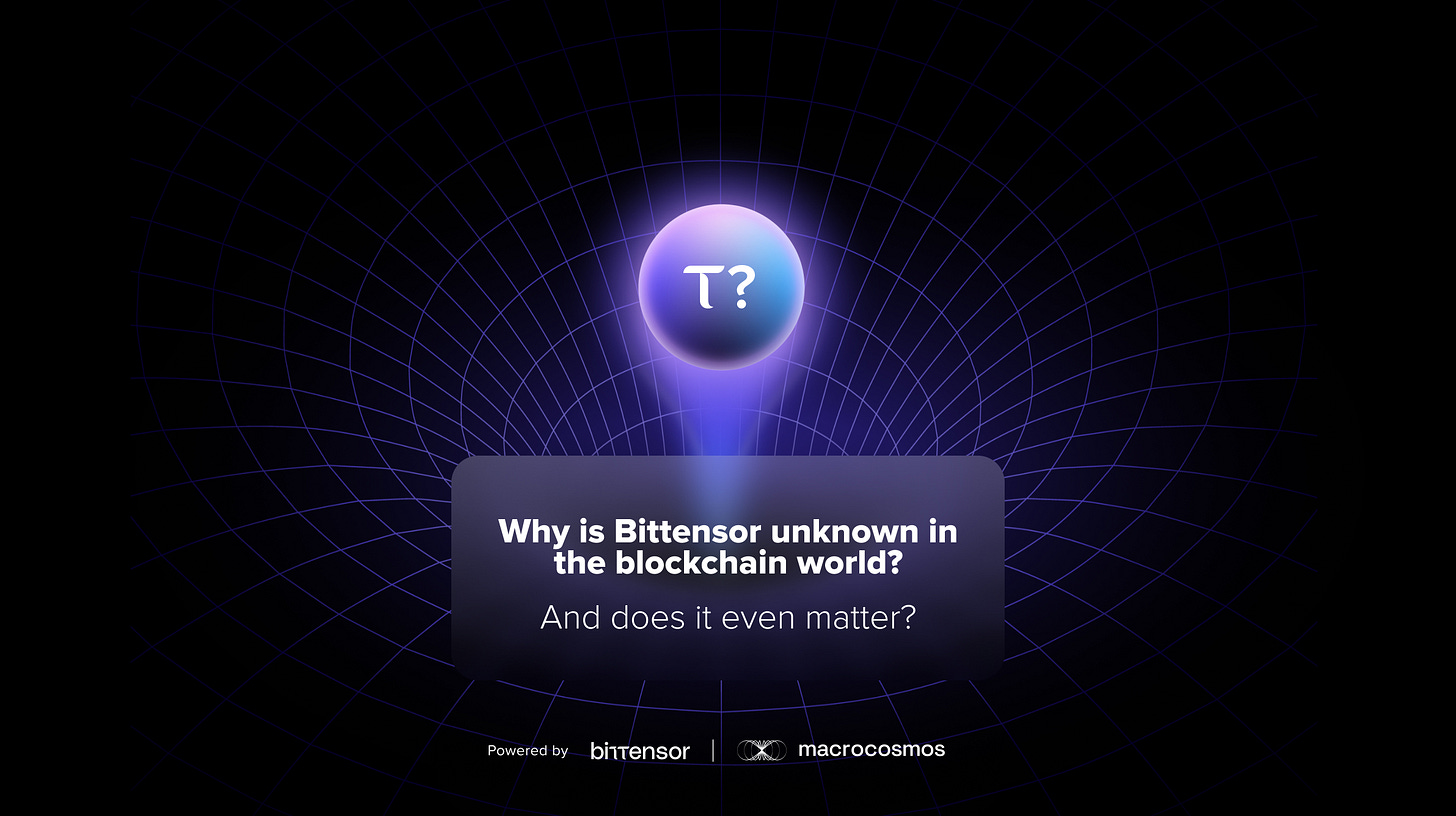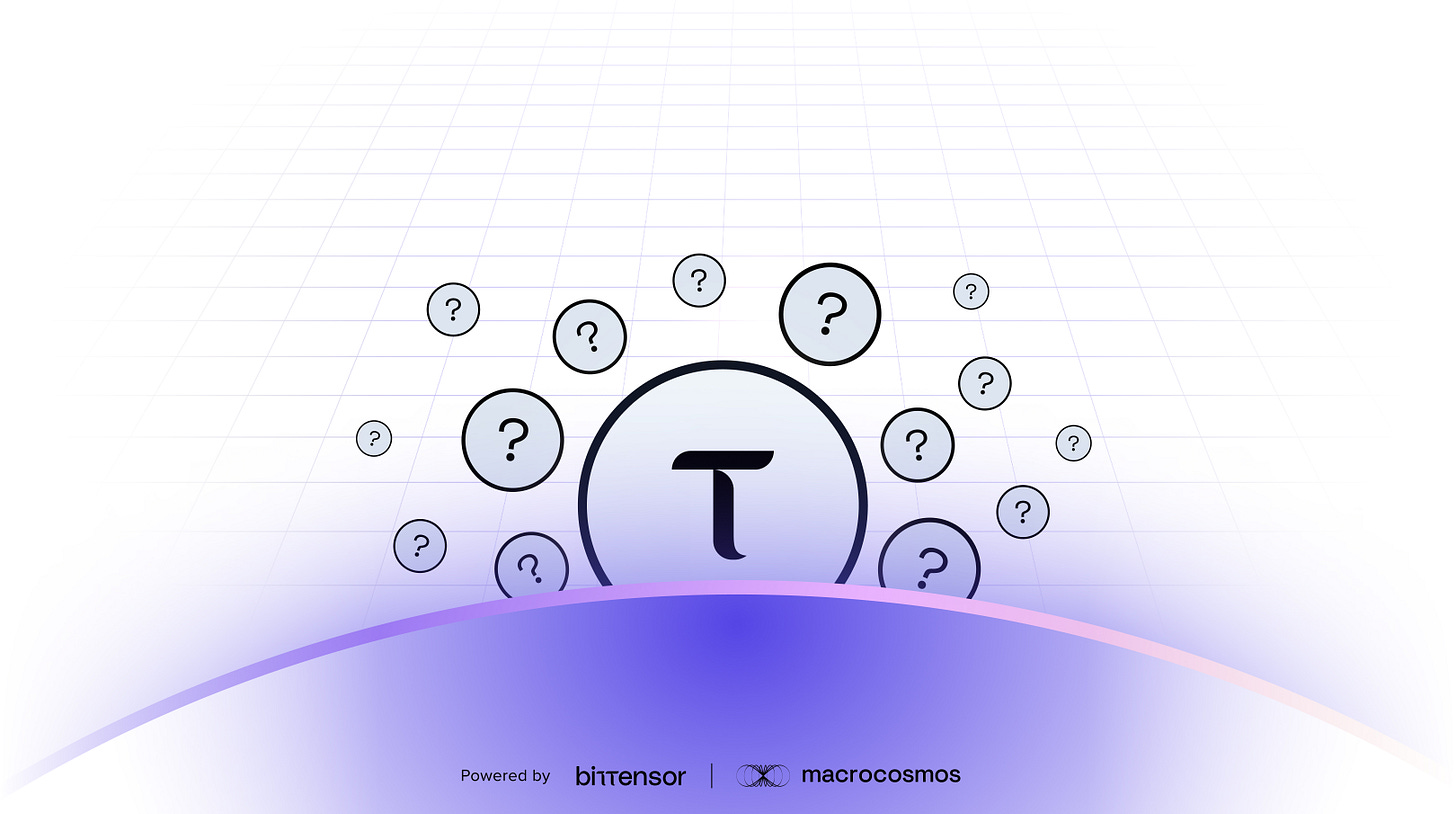Why is Bittensor flying under the radar - and does it matter?
Bittensor receives less attention than other blockchains, despite its diverse ecosystem and strong community. But that may not be the case for much longer...
You’re at a crypto event. You’re asked which projects you’re into. You say ‘I’m a fan of Bittensor’, expecting to spark a discussion. You think, maybe they’ll talk about dTAO, or about particular subnets, or discuss its architecture. But instead, all you’re met with are blank stares. Their response? ‘…What’s Bittensor?’
Bittensor is, at the time of writing, the top decentralized AI project on the blockchain by market cap. TAO regularly ranks in the top 30 cryptocurrencies, and its 90-plus subnets can do almost anything that any token or app can do - and it probably does it faster and cheaper, too. And if that wasn’t enough, Barry Silbert, perhaps the single biggest investor in crypto history, recently called Bittensor a better store of value than Bitcoin.
So…what gives? Despite all this, why is Bittensor comparatively still so unknown?
Even with a rich community, 90+ subnets, its own unique tokenomics, and a committed, proven team building it, Bittensor is pretty isolated. Many blockchains with much lesser members and ecosystems have greater recognition. So, what exactly has prevented it from gaining prominence, and more importantly, should we even care?
A complex cross-section
Bittensor lives in the middle of two intricate sectors - blockchain and AI. Neither space is exactly easy to understand, let alone build within. You can find tons of blockchain devs, ready to rally around their networks of choice, and even more AI and machine learning devs who know their craft inside and out. However, finding somebody with the technical prowess of both spheres is rare.
Anybody who’s big in Bittensor knows these people exist, as they’re the masterminds behind some of the most impressive subnets out there, but typical blockchains don’t ask for this level of skill. While a grasp of both areas is not necessary for every subnet, and certainly not needed for investing and following the space, it can give the impression that Bittensor has a steeper learning curve than other networks. In reality, you can get involved with curiosity alone, but that point’s easily missed at first glance.
Lack of clarity
The golden mantra of looking into a blockchain is to do your own research, and if you cannot grasp what Bittensor is doing, this simple logic indicates it’s smarter to step back and look elsewhere. Simple narratives bring people together, but Bittensor is building something that cannot align with the typical messaging of either the blockchain or AI space.
It’s an ecosystem, yet not in the same way as Ethereum, Cardano, or Solana. Building mostly comes at the subnet-level. This means you need to raise funds and secure a slot, as they’re relatively pricey (especially since dTAO). This isn’t a demerit - it raises the bar within the grand competition of projects - but it means a small team cannot launch something without capital, which can be an unexpected revelation to newcomers.
Clarity gets further skewed when you look at some of the terms Bittensor uses. A validator and a miner act very differently to their namesakes on other networks. They’re not securing the blockchain, they’re completing tasks and evaluating the work. If you’re a fan of Ethereum, Solana, Bitcoin, Monero, or pretty much any leading chain, you’ll likely feel confused by how these roles differ. It creates a language barrier. This is exactly why communication is needed, so we can teach people how it works and where it diverges from traditional chains.
A different kind of purpose
Bittensor has a strong focus on decentralizing AI, but over time, its goals have expanded beyond that. The community has taken it down a myriad of directions, some of which are not explicitly AI or machine-learning specific. This is good, as it marks a bustling network who are thinking outside the box and redefining its architecture. It’s very much in the spirit of decentralization. However, this can foster confusion. Once again, the narrative takes a hit.
Bittensor’s north star isn’t exclusively to imbue decentralization within AI, it’s technically to decentralize intelligence. Fundamentally, it facilitates people around the world to collaborate and compete on unified and precise goals… That’s not easy to convey, but nothing complex ever is when peeling back the layers. It’s a nervous system of incentives, compute, competitions, and distribution.
It’s not that you need to be smart to understand Bittensor - it’s that you need to be aware it’s playing a different game than other blockchains.
An ideological battleground
When OpenAI’s GPT 3 launched, it set the tech world alight. It felt like the future had finally arrived. It was bright, shiny, and it wasn’t decentralized. For several years prior, the blockchain community had presented crypto as the new wave of the internet. Many felt that web3 was owed that spot, only to have it usurped by a technology with a longer history and a centralized, corporate, core.
I went to a cryptocurrency conference just months after GPT 3 came out. The tone was somber. People felt like they’d lost the race to a competitor they didn’t even know was running. The hype built by the crypto-sphere was absent. The new technological age didn’t look cryptographic and distributed, it looked like easily accessible chat interfaces and image generation tools.
For a while, crypto and AI were seen as unmixable concepts. They weren’t conceptually or architecturally opposed, but when it comes to investment and interest, blockchain tech felt less exciting than it once was. It took a little time before people understood the two could co-exist and even help each other out. Bittensor entered the scene roughly one year after GPT 3 - meaning it was born on the frontline. At that point, many perceived projects trying to marry crypto and AI as mere attempts at stealing the machine-learning thunder and trying to stuff buzzwords.
Societally, we’ve matured, and so we now understand just how significant agency and self-sovereignty are in an age where the top AI services are operated by centralized corporations. If anything, decentralized intelligence is more appreciated than ever before, meaning Bittensor is right on time to change the world.
We’re a serious group
Since dTAO, our insular market has seemed like the cure to the Pump.fun era. One side is made up of carefully crafted, meticulous, and intelligent assets, whereas the other is littered with poorly ideated, humourous, and conceptually vapid tokens. Investors who understand this appreciate it, but in an age where assets can thrive on vibes alone, it can be hard to get attention. Clowns stand out in a crowd. The more goofy something is, the more noticeable it becomes. Rigorous, complex, and compelling assets need to state their case before they win you over.
Bittensor has always had a more composed and serious atmosphere. We’re made up of smart and driven individuals who want to build useful tools rather than shout about their achievements. However, if we want to succeed in the grand pantheon of blockchains, then we need to learn how to leverage the type of attention other assets get.
But… how known do we need to be?
All this talk of Bittensor’s smaller footprint in the world might leave you wondering why we should even care. We’ve got a rich ecosystem, a robust architecture, and a global presence, even if it’s not the same size as Ethereum or Bitcoin. To what extent does recognition matter?
The answer depends on what we truly want out of it. Being known is good for investments, and a higher value brings more funding to teams. However, that type of model means more for some blockchains than it does for Bittensor. Many projects launch a coin or token as a way of raising capital, but Bittensor has built a rich system without the same level of fanfare. The desire for a more recognizable network might come from a bygone era in crypto, where people saw most chains at odds with each other. The aim wasn’t for a diverse sector, but for one blockchain to rule them all.
The tribalistic yearning to be seen might be outdated and irrelevant for Bittensor. We don’t have all that many direct competitors, so is there much point in towering over them? Besides, Bittensor is about more than crypto - it aims to change the relationship between individuals and intelligence. In other words, it’s an infrastructure-focused technology.
Perhaps its future isn’t one of name-recognition, and perhaps that doesn’t change anything. For instance, most people don’t know about Flexera, Ellucian, Ansys, or tons of other companies out there that significantly impact how we engage with tech. In fact, some people might enjoy Bittensor because it doesn’t shout about itself. Rather, it quietly pushes along and iterates, inviting those who are curious enough to follow, without pressing itself in their faces.
Bittensor is operating on a different frequency than other chains, with different overarching goals. While greater knowledge among crypto users is useful for visibility and growth, if the last couple of years have taught us anything, it’s that Bittensor is more than capable of revolutionary feats with the crowd it’s currently got.
To learn more about Bittensor and Macrocosmos, come and chat in our Discord and Telegram.










